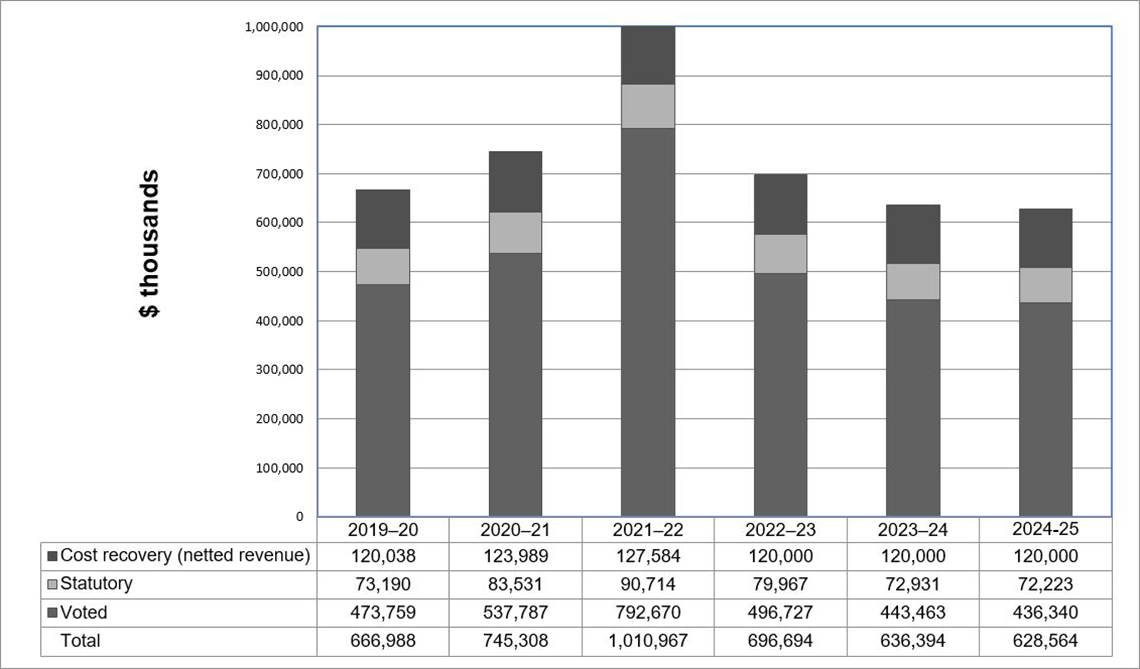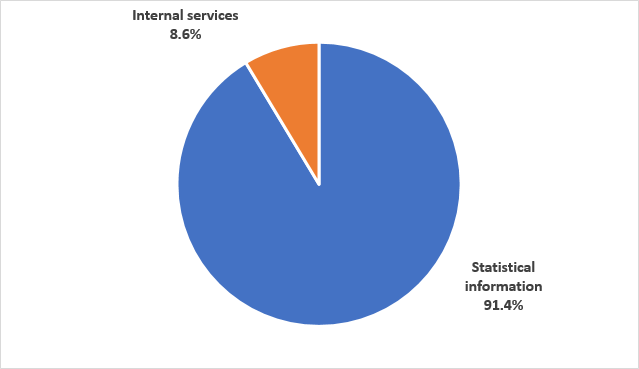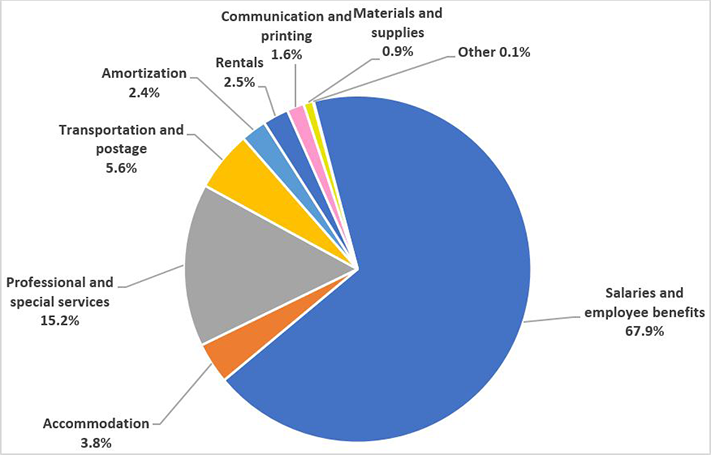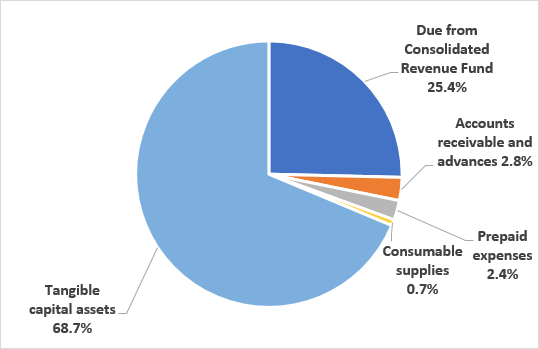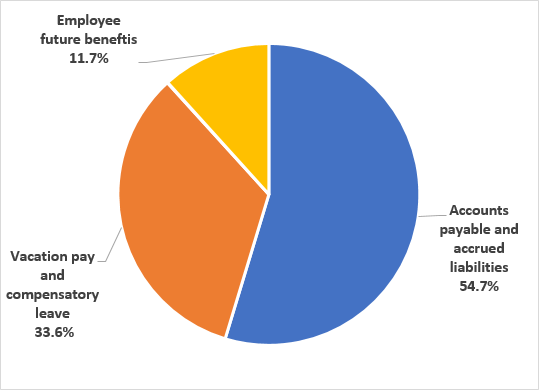Eh Sayers Episode 9 - Sylvia Ostry: Lessons From A Legend
Release date: October 7, 2022
Catalogue number: 45200003
ISSN: 2816-2250

Social media shareables
Social media shareables
Tag us in your social media posts
Visuals for social media
Sylvia Ostry graphic (PNG, 451 KB)

If this is the first time you're hearing about Sylvia Ostry, buckle up.
Ostry was appointed Canada's first and only female chief statistician in 1972, but she didn't get there by playing by the rules. She was ambitious but grew up in a world where many thought that it was shameful to be female and have a career.
Sylvia was a Jewish woman in economics, and even after she earned a Ph.D. from the University of Cambridge, she was denied a job with the United Nations because of her gender. Nevertheless, she had a storied career, becoming the Chairman of the Economic Council of Canada then the Chief Economist at the OECD. But we're not focusing on her career highlights. We're going behind the scenes to look at how she challenged herself to succeed, becoming both a respected economist and mother, and how she handled setbacks, and discrimination, all while staying true to herself and demonstrating the integrity for which she's remembered today.
We're celebrating the 50th anniversary of Sylvia Ostry's appointment as chief statistician. In this episode of Eh Sayers, featuring interviews with her sons, Adam Ostry and Jonathan Ostry, we are pleased to introduce you to this remarkable woman and to share with you eight pieces of advice inspired by her life.
Host
Tegan Bridge
Guests
Adam Ostry, Jonathan Ostry
Listen to audio
Eh Sayers Episode 9 - Sylvia Ostry: Lessons From A Legend - Transcript
Transcript
Tegan: Welcome to Eh Sayers, a podcast from Statistics Canada, where we meet the people behind the data and explore the stories behind the numbers. I'm your host Tegan Bridge.
In 1972, Sylvia Ostry became the first, and (so far!) only, female Chief Statistician of Canada. 50 years ago, the world was a different place. NASA was launching their Space Shuttle Program and the Godfather was in movie theaters.
The workplace was changing, with more and more women working outside the home than ever before. In 1972, 45% of women aged 25 to 54 participated in the labour market, that is, were employed or looking for a job. While that might seem like a relatively small percentage today, it represented a huge shift at the time. A decade earlier, in 1962, it was only 32%. That's a 40% increase in just ten years.
In 1952, while Sylvia became a lecturer at McGill, women in her home province of Manitoba were given the right to be jury members. Sylvia began working as the Director of Special Manpower Studies and Consultation at StatCan in 1965. Just one year before that, in 1964, women were given the right to open a bank account without their husband's signature. And in 1971, the year before Sylvia was made Chief Statistician, Manitoba stopped firing female municipal employees after they married.
When Sylvia Ostry was appointed head of the Economic Council of Canada, the Globe and Mail published an announcement at the bottom of the fifth page of the women's section.
Sylvia passed away in 2020, and to celebrate her, we're taking a look back at her life to see what we can learn from her.
You'll be hearing Sylvia's voice through clips from an interview she gave to Bronwyn Bragg and Mary Breen, recorded on May 28th, 2008.
So, here are 8 pieces of advice from the life of Sylvia Ostry.
(Chime)
Number one. Challenge yourself.
When you think about people who led remarkable lives, it's difficult to imagine who they were before they made it. Before they were successful.
Sylvia Ostry came from humble roots.
Adam: So, my name is Adam Ostry and Sylvia Ostry was my mother.
She was a pioneer, you know. Um. My her parents, now her mother had graduated from normal school in Winnipeg. She was an immigrant from England. She was born in in London. Tottenham Court Road. Can't get more working class than that in the 19-- in the 1890s. She, you know, she came from nothing. They had no money. They were penniless immigrants. My grandfather made money and then lost it during the depression and never really gained it back. You know my and my grandmother. Her mother was ended up being a she was a primary school teacher after having gone to normal school in Winnipeg. But that was it. She was the first uh, her and her brother were the first people to go on to graduate school and to get doctorates at universities. I mean. And then she rose to the top through sheer hard work.
Tegan: Sylvia Ostry challenged herself. She was intelligent and a hard worker, and she challenged herself to succeed.
In her own words;
Sylvia Ostry: at the University of Manitoba to get into medical school it was very difficult, it was a first-class medical school but it covered the whole of western Canada, there was no other medical school at that time and it was very difficult for a woman, I don't remember how many there were since the beginning not more than a handful, and it was much more difficult to be a Jew, so to be a female Jew really appealed to me that I would get in. I had two friends in high school very bright, and we sat down and said look we're going to do our pre-med and we'll going to get the highest marks in Western Canada, because we'll organize ourselves to study and we'll share notes and we'll get money and hire a special people that can teach us and we'll go one, two, three and I said, if they keep us out, we'll sue them, which sounds very strange at that time but I felt very strongly about that, but we did that.
Adam: The things that she respected the things that that she respected the most in people were talent and intelligence, integrity, so honesty, and hard work and discipline. So you know if given the opportunity to or one of her favorite expressions was to goof off, that's a very kind of 1950s expression, goof off, and she would invariably accuse me of goofing off when I wasn't doing my homework or wasn't working. But you know she when given the opportunity to goof off or to work she would invariably choose work.
(Chime)
Tegan: Number two. Follow your passions, even if they take you in an unexpected direction. Maybe especially then.
I think that quitting gets a bad rep. Have you heard of the sunk cost fallacy? Basically, it's when people tend to keep going with something if they've invested a lot of time, effort, or money into it, even if it no longer serves them or it's something they don't want anymore. You can apply this to things like relationships or jobs. I would like to actually encourage you to utilize strategic quitting. And I think Sylvia would too.
Sylvia realized during a visit to her brother, who was studying at Queen's University, that she wanted to study social sciences. The conversations she saw the students having about things like art, politics, and the economy were much more interesting to her than her studies in medicine. She wanted to join them. But to do that, she would have to quit medical school.
Sylvia Ostry: The first year was very boring, just anatomy and physiology and biochemistry and I got a 99 in biochemistry and the other two but that summer I went to see my brother who was at Queens and I spent the summer in Kingston and it was though I had gone to Mars, I had never met people who read books and talked about history and all I'd ever done was study.
I went to see the Dean of the medical school and I said, I really feel badly but I want to leave medical school because its so boring and he exploded and he screamed, you're the best example of why we will not let women in medical school, how correct we were to keep you out, you realize that you are keeping a man out and I said I know I'm sorry but I want to study something else. And he said, that's a lie, you're like all women, you're dropping out so you can go out and get married. I said, it's not true, I'm going to be a doctor, but it'll be a PhD, not a medical doctor. He said, that's a lie and I went out.
Jonathan: my name is Jonathan Ostry. I'm the younger son of Sylvia and Bernard Ostry.
She started off thinking she wanted to be a physician, a doctor, a medical doctor. And I think what had drove her in that direction is, you know, always choose the thing that is the most difficult, the most impossible and see if you can kick the ball through the goal post just for the heck of kicking the ball rather than specifically because this is your passion. And you know, she realized this this really wasn't her passion. And she had chosen this, this direction merely for the reason that I just said. And that was a a very poor reason to kind of motivate what you are gonna do for your life. Right. And so she decided she wanted to go into economics.
Tegan: For Sylvia, the most important thing wasn't necessarily what she was taking. It wasn't the topic of study. It was instead:
Sylvia Ostry: the concentration on learning and I came to McGill and I didn't want to take economics, I didn't care what I took but what happened was they said take economics we think you can do two years and…
Jonathan: I never really thought of my mother as an economist. I mean, she is an economist by training, but you know. But, you know, the is my mother, an economist, did I think of her as an economist? I really thought of her and my father as people who knew everything about everything.
(Chime)
Tegan: Number three. Refuse to accept the limitations put on you by other people.
Sylvia faced discrimination all her life. Even after earning a PhD, she was denied a job at the UN because she was a woman.
Sylvia Ostry: My initial thing was that I wanted to be a development economist and I went to the UN and I had my PhD and I went to see the person who was in charge of it all and I said I have all the qualifications and I would love to work here and he said, look, I might as well be clear to you, no government in the developing countries will hire a woman, and he said you'd better find another career, it's amazing how people could say things like that but it was honest and so when I went to McGill I had to find another, and I was very interested in labor economics so that's what I worked on.
Adam: My mother fought the good fight. She had, she had career disappointments. I mean, my mother wanted to be. My mother wanted to be Deputy Minister of Finance and then governor of the bank, you know. And she was a product of her time, and there was no way they were going to give those jobs to a woman. And she knew it. She was told that. You know, and it's uh. It's. It's. I... she made the best of... You know there's an old expression. You dance with the guy that brung you. And the fact is, is that what she made the best of the of the hand she was dealt,
Tegan: Although she was refused by the UN, she didn't let that stop her. Sylvia didn't quit when she was faced with a roadblock. She found her own way to succeed and refused to accept the limitations put on her by others. And you shouldn't either!
Jonathan: As an economist she had nine lives, right? She didn't just change from medicine to economics. She did her PhD at Cambridge on what today would be considered the most arcane obscure topic. she wrote, her thesis on the sort of this Soviet planning Soviet economic planning as it pertained to newly independent India. She didn't. She didn't work on Marx economics or development economics or Soviet planning. She went to the Oxford Institute of Statistics and Economics and she did other things. She became a labor economist. And then she became an expert on the Canadian labour market and all the challenges for the Canadian economy. She was chair of the Economic Council, Canada. She became an expert on regulatory and microeconomics when she was deputy at consumer and Corporate affairs. And then she became a formal global expert on international trade, which is a completely different topic. She so she reinvented herself. Yeah, in many in many different ways. She had the inner confidence and strength. To know that she could do it.
(Chime)
Tegan: Number four. When faced with a problem, try changing your perspective.
Prior to Sylvia's tenure as Director of Special Manpower Studies and Consultation, StatCan studied the labour supply by focusing on how many men were working and how many men wanted to work.
Sylvia Ostry: The first job they gave me at Statistics Canada was terrific, they gave me, it's a wonderful title today but it didn't bother me, called special manpower studies but it was very interesting they let me attach separate questionnaires to the household survey so I could get information on a whole range of things that nobody else had and we produced and I was able to hire academics and we produced some incredible studies, so I loved the job, it was really fascinating, and indeed some of my early publications were very important in the US, we developed new ways of looking at things, we developed ways, I wanted to develop measures on the amount of demand and not just supply.
Tegan: Sylvia wanted to look at labour supply from another angle. She wanted to look at the participation of workers in the labour market and why someone would choose not to participate in the labour market, not get a job, whether they might want to work under different conditions.
The Manpower Studies gave Sylvia the resources to study the Canadian labour force more closely, in a way that had not been done before. StatCan had been measuring the labour supply for a long time, but manpower was a bit literal and focused on men. Sylvia saw the value in expanding our research by including other groups in new measurements. Sylvia reimagined how we'd think of labour, of manpower, to expand the analysis to include not just men, but women as well. She studied the participation of women in the labour market- the question of what made a woman choose to work, or not to work, and the effect of factors like education, husband's earnings, and children on that decision. This was a big deal at a time when, in the words of economist Joan McFarland, "most of the analysis in economics… ignored the role of women in the economy altogether."
Sylvia Ostry studied the lifetime productivity of a person and the lost output from their premature death or retirement. The labour force participation and potential earnings of both the economic man and the economic woman are included, the first Canadian study of its kind.
Sylvia issued a challenge to traditional economics to change its perspective, not just looking at men but at women, and in doing so, increased our understanding of labour economics.
(Chime)
Tegan: Number five. Live by your own definition of success.
Sylvia Ostry herself was a mother and she also had a career, something other people sometimes judged her for.
Bronwyn: What did the people close to you – your friends and family and wider social network – what did they think of your choices?
Sylvia: Well, in Ottawa I was told that a large number of women were shocked and horrified that I was working they thought that was just appalling, I had children and I was working full-time. They never said this to me, but I heard this from a number of people. The only time there was anything overt was when I was appointed to the OECD, this was '79, I'm told that the wife of the Ambassador told her husband that I was not allowed to enter the Embassy because I was such a disgrace that she could not have me. I was married, I had two children, how could I come to a place like the OECD and be head of it? The chief economist and it was just disgraceful for a woman to be working
Jonathan: You know, when my mother went to the OECD as its chief economist, there were a number of firsts, and maybe and maybe more firsts than when my mother became chief statistician because she became chief statistician in Canada. Which was her country. Uhmm, and you know, you can say that because it's her country, there's a certain comfort level from rising in your country. But when she got the job at the OECD, most people in Paris were absolutely incredulous because first of all, that job had always really been the purview of the of a European citizen, a citizen of Europe. And Canadians or Americans, but you know, Canada was like a backwater and what is this Canadian woman coming to Paris for? That's one. So that was one thing. The other, there was very much, it was a quite a misogynist environment. And I can certainly well appreciate that my mother would have heard whispers and you know in the in the corridors about God, this, what is this woman doing here? That's so it's Canadian, there's woman and just this sense, that boy, she's not one of us. I mean it. It's just so many, well, probably being Jewish. So. So, you know, it's just like, you know, not part of that club and so and so you'll talk about being out of your comfort zone.
Tegan: We all get to decide for ourselves what success looks like. And if you would like to follow in Sylvia's footsteps and define success as raising two children and also becoming the Chief Economist at the OECD, yes! More power to you. You go Glen Coco.
(Chime)
Tegan: Number six. When prejudice closes a door, break that door down.
You might have heard the expression "when one door closes another opens." Maybe that's true. But. It's also true that sometimes doors are closed because of prejudice. And when those doors close, you kick them wide open. This maxim could apply metaphorically to many stories from Sylvia's life, but sometimes we actually mean it pretty literally.
Sylvia Ostry: The funniest thing was when Flo Byrd had her first meeting to discuss the Royal Commission on Women, it was held at a very fancy club in Ottawa and I was coming into have lunch with her and I was stopped at the entrance and I said, I'm sorry, I have a luncheon meeting with Senator Byrd. They said, you can't come in this door, I said what do you mean I can't come in this door? Not allowed, as a woman, you have to go in the side door. So I burst out laughing, I said, that's good cause we're having a meeting on a Royal Commission for Women and I'll make sure that this place is either closed or you open the front door.
(Chime)
Tegan: Number seven. Surround yourself with people who love and support you.
You know what they say. Haters gonna hate (hate hate hate). But take it from Sylvia. Surrounding yourself with people who love and support you makes all the difference. For Sylvia, it was her husband, Bernard.
Sylvia Ostry: My husband was just the most extraordinary man and as I said I had known him since I was five years old.
Adam: She wouldn't have survived without my father the ones that my father, my mother was. My mother was blessed with having my father as her husband, my father loved my mother, adored my mother, worshipped the ground she walked on uh for all sorts of reasons. My mother was. My mother never forgot the degree to which she was loved by him. Umm. And you know her two children were privileged to have grown up and to have been raised by two people who loved The way my parents loved each other. my family, my, my, my parents stayed married to each other for 50 years. And it was, uh, my mother, my mother, my mother expressed her love for my father in differently than the way my father expressed his love for my mother. I mean, my father's collecting of Art Nouveau and Art Deco furniture and objets d'art, which you could now see in the Royal Ontario Museum is a testament to his love for her. He did that not because he was interested in the period. He did that because she was. She had an intellectual interest in the Vimar Republican and French Art Deco. She was interested in the period she was interested in the in the political [unintelligible] and turmoil that was going on in the 20s and 30s and in Western Europe, notably France and Germany. 28:43 Umm. And so my father decided that he would begin surrounding her with the tangible illustrations of that period. That was the way he expressed his love for her. In all her major, major career um decisions in life she couldn't do anything without first consulting with him. And if you look at the career path, I don't think you'll find any examples of the husband consciously giving up career opportunities so that his wife could pursue her career. Even today, I dare say that there are the examples are few and far between.
Sylvia Ostry: I was appointed Chairman of the Economic Council and I was at the office one morning when I got a call from Paris and the assistant to the Director General, phoned and said the head of the economics department is leaving, he's retiring and we'd be very interested in interviewing you and the Director General wants to know if you'll come to Paris. And I was staggered and I said, well, I could get back to you on Friday, this was Wednesday and I came home that night and I had this insane call from Paris and I described it and I said I'll be polite and wait till Friday, and then I'll tell them and he said are you crazy? I said, what do you mean? He said, you'll never have another offer like this for the rest of your life that's a crucial job, he was right, it was very important at that time, I said what do you want me to do, I can't do it, he said yes you can, you're going to go and I'll work something out. That's what he was like. I couldn't be where I am without him.
(Chime)
Tegan: Number eight. Work hard.
Our last piece of advice comes straight from Sylvia Ostry herself.
Bronwyn: I was wondering if I could ask you if you have any advice for young women?
Sylvia: Yeah. I think my advice is what I did myself: You must be determined to be the best in what you do and you have to be disciplined and you have to work hard. I know it sounds platitudinous but that's what I did. I never thought about power, getting jobs or anything, I just wanted to do better than anyone else. And I was like that from when the time I was in grade 1.
Adam: Sylvia Ostry was a complicated and complex human being. She was highly intelligent. She was driven by her need to work. She expressed her identity through her work. And she devoted her life to. To work . She was full of integrity. She. She was brutally honest, first with herself and then demanded no less from others, starting from starting with her children. And so as a mother, she taught me, she tried anyway to teach me very early the discipline of work and of being honest with yourself in terms of what you can and cannot do. She believed very strongly in in trying to be the best that you could be and trying to. She always had a an expression that she would use with me whenever I would collapse and say that I couldn't do it she would get very upset and angry and say that you're not working hard enough. And if I had a goal that that I would then say I would never be able to she always said your reach should exceed your grasp. And then she lived by that credo for her entire life.
Jonathan: Sylvia dedicated her life to improving the welfare of Canadians. She was, you know, a not only a great intellectual, very broad in terms of, you know, her areas of expertise but also not interested in knowledge for knowledge's sake. She was interested in how to leverage knowledge to uh to guide policy with the ultimate purpose of the well being of Canadians or in a in a larger canvas. The world. And this is what she devoted her life to.
Adam: She committed, she devoted her entire life, her entire working life, to public service. There is no nobler calling and she as an is an exemplar of that. And I think that, you know, Canada recognized that. She died a companion of the order. But you know, she um if people remember her, I hope people remember her for her contribution to making Canada a better place in which to live.
(Outro)
Tegan: You've been listening to Eh Sayers. Thank you to Sylvia Ostry's sons, Adam Ostry and Jonathan Ostry, for their special contribution to this episode. Thank you to Joan McFarland for help with some of the economic concepts. To the librarians at Library and Archives, who helped us with the research. And to University of Ottawa Library Archives and Special Collections, who gave us permission to include excerpts from Bronwyn Bragg and Mary Been's 2008 interview with Sylvia Ostry.
You can subscribe to this show wherever you get your podcasts. There you can also find the French version of our show, called Hé-coutez bien. If you liked this show, please rate, review, and subscribe. Thanks for listening!
Sources
"Canadian Women's History." 2013. PSAC NCR. Public Service Alliance of Canada. January 9, 2013.
McFarland, Joan. 1976. "Economics and Women: A Critique of the Scope of Traditional Analysis and Research." Atlantis: Critical Studies in Gender, Culture and Social Justice 1 (2): 26–41.
Ostry, Sylvia. 2008. Sylvia Ostry Interview by Bronwyn Bragg and Mary Been. University of Ottawa Library Archives and Special Collections.
"The Surge of Women in the Workforce." 2018. Statistics Canada. May 17, 2018.
















